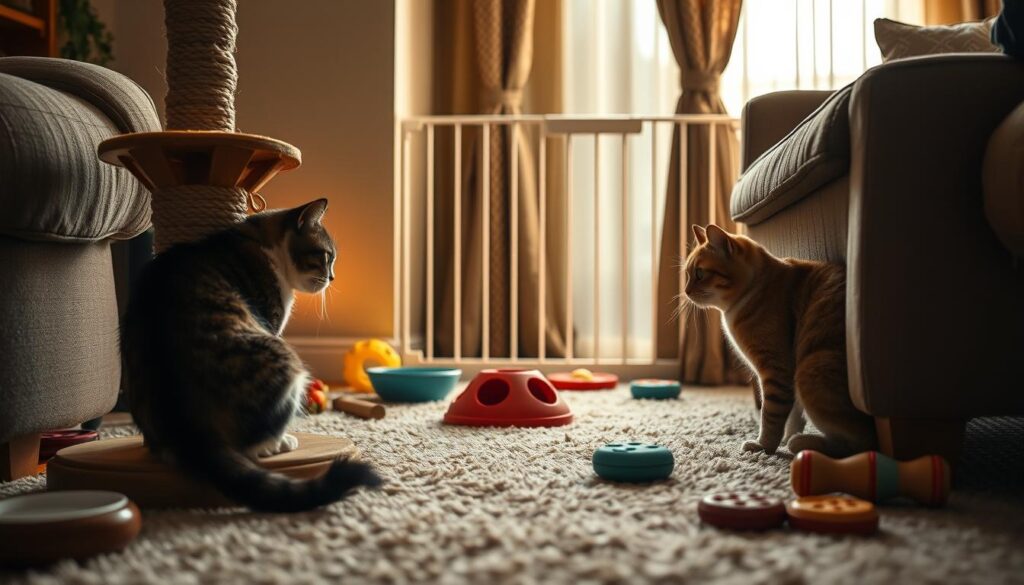Bringing a new cat home can be very rewarding. But, it needs careful planning and patience. It’s key to introduce new cats smoothly to avoid stress and anxiety.
Introducing a new cat can be tough, but it can also be a great experience. Start by preparing a separate room for the new cat. Make sure you have all the supplies ready. Let the cats get to know each other’s scents before they meet face-to-face. A good plan is essential when bringing a new cat into your home.
In this article, we’ll share important tips for introducing a new cat. We’ll cover preparation, introduction methods, and caring for your cats after they meet. This guide is for both experienced and new cat owners. It aims to help you make the transition smooth and stress-free.
Introduction to Successful Cat Integration
By using the right tips, you can create a happy home for all your cats. The secret to success is patience, persistence, and being open to change. Your pets’ needs may shift, so be ready to adapt.
Key Takeaways
- Prepare a separate room for the new cat before bringing it home
- Provide all necessary supplies, including food, water, and litter
- Allow the cats to get used to each other’s scents before a face-to-face meeting
- Follow a gradual introduction process to prevent stress and anxiety
- Be patient and flexible when introducing a new cat to your household
- Monitor the behavior and health of all cats during the introduction process
Understanding Your New Cat’s Needs Before Arrival
When you bring a new cat home, it’s key to think about the new cat introduction process. You’ll need food and water bowls, litter boxes, scratching posts, and toys. A well-prepared home reduces stress and makes the cat introduction tips work better.
Creating a safe, quiet space for your new cat is vital. Make sure this room is cat-proofed, without dangers. Adding cat shelves or towers gives your cat a sense of security and lets them watch their new home.
Essential Supplies Checklist
- Litter boxes and litter
- Food and water bowls
- Scratching posts
- Toys and interactive playthings
Creating a Safe Space
Follow these cat introduction tips to make a safe, welcoming space for your new cat. Offer lots of hiding spots and vertical spaces. This helps your cat feel secure and keeps them stimulated.
Preparing Your Home for the New Addition
When introducing a new cat to your home, preparation is crucial. Before bringing your new cat home, make sure your living space is ready. This means removing hazards, setting up feeding and litter areas, and creating cozy spots.
To make your home welcoming, use pheromone diffusers or sprays. They help calm your cat and reduce stress. Keep your home quiet and calm during the first few days. Here are more tips to prepare your home:
- Set up a separate room for your new cat with all the essentials, like food, water, litter box, and scratching posts.
- Keep toxic substances and electrical cords out of reach.
- Provide hiding spots and vertical spaces for your cat to climb and watch its surroundings.
By following these how to introduce a new cat tips, you can make a safe and welcoming space for your new cat. Always put your cat’s safety and well-being first. Be patient during the introduction process. With time and patience, your new cat will become a cherished family member.
First Day Tips for Introducing New Cats to Their Environment
When you bring new cats home, their comfort and safety are top priorities. The first day is key to a smooth start. Follow expert advice to make this transition easy for your new pet.
Creating a calm space is essential. Give them a quiet area with everything they need, like food, water, and places to hide. Keeping stress low, especially when they arrive, is important. Gradual introduction to new places and people helps reduce anxiety.
Initial Room Setup
Creating a “safe room” is crucial. It should have all the basics to make your cat feel safe and relaxed. Make sure to include:
- Litter box and litter
- Food and water bowls
- Comfortable bedding
- Hiding spots, such as cardboard boxes

Establishing Routine
Starting a routine right away is important. This means regular times for eating, playing, and quiet time. A steady routine builds trust and security. By following these tips, you can help your new cat feel at home.
The Importance of Proper Cat Socialization
Proper cat socialization is key for a new cat’s smooth transition. Kittens are most open to socialization between 2 and 14 months. Adult cats may find it harder, but patience and consistency can help them trust and interact better. Tips include gradual exposure to new things and using positive reinforcement like treats and praise.
Remember, socialization isn’t just about humans. It’s also about other pets and common sounds. Socializing your cat to these can reduce fear and aggression. Practical tips include handling exercises and creating a safe space for them to explore.
Introducing cats to other pets, like dogs or cats, should be done carefully. Start with visual introductions, then move to supervised meetings. By following these tips, your cat can become confident and calm in your home.
- Gradual exposure to new people, places, and experiences
- Positive reinforcement techniques, such as treats and praise
- Handling exercises, such as gently petting or stroking
- Controlled introductions to other pets, starting with visual introductions
By focusing on proper cat socialization, you can ensure your cat’s happiness and health. This will also help create a peaceful home for all cats.
Step-by-Step Guide to Introducing Cats to Each Other
Introducing cats to each other needs patience and a slow approach. This helps avoid stress and fights, making a peaceful home for all. The steps include scent exchange, visual introduction, and supervised meetings.
The scent exchange is a key step. It lets cats get used to each other’s smells before they meet face-to-face. Swapping bedding or toys helps them feel comfortable with each other’s presence.
Scent Exchange Method
- Swap the cats’ bedding or toys to exchange their scents
- Use towels to transfer their scents, allowing them to become familiar with each other’s presence
Visual Introduction Process
After they’re okay with each other’s smells, it’s time for a visual introduction. Keep them apart but let them see each other through a door. This lets them get used to each other’s looks without a face-to-face meeting.
Supervised Meeting Guidelines
When they seem comfortable, it’s time for a supervised meeting. Choose a neutral area with lots of space. Watch their behavior closely for signs of stress or aggression. With patience, you can make introducing cats to each other a success.
Common Behavioral Challenges During Integration
When you bring a new cat home, you might face some behavioral challenges. Cat integration tips can guide you through these issues. One big problem is territorial marking. Cats may pee or scratch to mark their territory.
Introducing new cats smoothly involves giving them their own resources. This means having separate food, water, litter boxes, and scratching posts. This helps reduce stress and competition. Aggression, hiding too much, and changes in litter box habits are also common. It’s important to know the difference between normal and abnormal behavior.

- Gradual introduction to new environments and pets
- Providing a safe space for each cat to retreat to
- Monitoring behavior and adjusting the introduction process as needed
By following thesetips for introducing new catsand being patient, you can help your pets get along. If problems don’t go away, getting help from a vet or animal behaviorist is key. This ensures your pets stay happy and healthy.
Creating Harmonious Multi-Cat Spaces
Introducing new cats to a home needs careful planning. It’s key to make sure the environment supports harmony. Providing multiple resources like food stations, litter boxes, and scratching posts helps reduce stress and competition. This way, cats can live peacefully together.
It’s important to distribute resources well. Each cat should have its own food, water, and litter. Here’s how:
- Multiple feeding stations prevent fights over food.
- Separate litter boxes keep things clean and stress-free.
- Scratching posts meet their natural needs.
Managing territory is also crucial. Vertical spaces and room dividers help cats have their own areas. This reduces fights. Cat trees and hideaways also help, making a calm and relaxed space for each cat.
By using these strategies, you can create a peaceful home for all cats. Good tips for introducing new cats are essential. They help make a stress-free space where cats can enjoy each other’s company.
Health and Safety Considerations
When you bring a new cat home, think about their health and safety. Make sure both the new cat and any pets you already have are up-to-date on their shots. Shots like rabies and distemper protect them from serious diseases.
It’s also important to take your cats to the vet before and after the new cat arrives. This helps keep an eye on everyone’s health and catches problems early. Plus, you should keep the new cat separate from others at first to avoid spreading sickness. This usually means keeping them in a room by themselves for a bit.
Vaccination Requirements
Vaccines are key to keeping your cats healthy. Talk to your vet about the right shots for your pets. They might need core vaccines and maybe some extra ones, like for feline leukemia or immunodeficiency virus.
Quarantine Protocols
Quarantining the new cat is a big part of introducing them to your home. Keep them in a separate room with their own stuff for a while. This lets you watch their health and keeps your other pets safe. Usually, you’ll want to do this for 7-10 days.
By following these steps, you can make sure bringing a new cat home goes well. You’ll create a happy and healthy home for all your cats.
Building Trust Through Positive Reinforcement
Building trust is key when you’re new to cat socialization. Positive reinforcement is a big help. It lets you build a strong bond with your cat. Use treats, toys, and praise to make your cat see you as a positive influence.
It’s important to respect your cat’s space. Let them come to you when they’re ready. Never push them to interact. This makes your cat feel safe and more likely to trust you. For shy cats, go slow. Use cat introduction tips like gradual exposure to new things.

- Offering treats and rewards for desired behavior
- Using clicker training to encourage positive interactions
- Providing a safe and comfortable environment for your cat to relax and feel secure
Follow thesetips for new cat socializationandcat introduction tips. They help your new cat feel comfortable. This builds a strong friendship that lasts a lifetime.
Managing Feeding Times and Food Resources
When you bring new cats into a home with other cats, it’s key to manage feeding times and food. One important tip is to have separate feeding spots for each cat. This helps avoid fights over food and reduces stress during meals.
It’s also crucial to make a feeding schedule that fits all cats. This schedule should consider each cat’s diet and preferences. For instance, some cats might need to eat more often because of health issues or age. A schedule ensures each cat gets the food they need without feeling left out or fighting for it.
- Feed cats at the same time each day to establish a routine
- Provide multiple feeding stations to reduce competition
- Consider automated feeders for cats with specific dietary needs
By following these tips and thinking about your cats’ unique needs, you can make mealtime peaceful and stress-free. This is key for successful cat integration.
Signs of Successful Integration
When you bring a new cat home, it’s key to know when they’re getting along. One big sign is when they groom each other. This shows they care for and trust each other, which is a big tip for introducing new cats.
Another sign is when they play together. Playing helps them relax and get closer. You can help by giving them toys and scratching posts. This way, they’ll have fun and not fight as much. By doing this, you make a peaceful place for your cats.
As they get more comfortable, they might sleep next to each other. This means they trust each other and are doing well. Watching for these signs and using the right tips for introducing new cats helps your new pet settle in smoothly.
- Mutual grooming and affection
- Playing together and sharing toys
- Sleeping in close proximity
By noticing these signs, you can make your cats’ introduction better. This way, they can live happily and healthily together.
Troubleshooting Common Introduction Problems
Introducing a new cat to your home can face challenges. Knowing how to introduce a new cat and using effective tips can help. Aggression between cats is a common issue. It’s important to spot signs like hissing, growling, or swatting and act fast.
Reducing stress is key to less aggression and a peaceful home. Use pheromone diffusers, play calming music, and engage in play. These steps can help make the introduction smoother and more enjoyable for your cats.
Aggression Management
- Identify signs of aggression, such as hissing, growling, or swatting
- Intervene promptly to prevent escalation
- Use positive reinforcement techniques to encourage calm behavior
Stress Reduction Techniques
- Use pheromone diffusers to mimic natural calming scents
- Play calming music to create a soothing atmosphere
- Engage your cats in interactive play sessions to reduce stress and promote bonding
When to Seek Professional Help
If aggression or stress persists, get professional help. A vet or certified animal behaviorist can offer tailored advice. They can help you overcome these issues and ensure a successful introduction.
Your Path to a Happy Multi-Cat Household
Bringing a new cat into your home is a journey. With patience and consistency, you can make a harmonious multi-cat environment. The tips for introducing new cats in this article are a great start. Positive reinforcement and a slow approach are crucial for trust and understanding among your cats.
Starting this new chapter, remember to keep up with vet visits, playtime, and enrichment. These steps help keep your home peaceful for all cats. By following these tips and listening to your cats’ needs, you’ll create a loving and enriching home for them.
FAQ
What are the essential supplies I need to have ready before bringing a new cat home?
Before your new cat arrives, make sure you have the following essential supplies: litter boxes, high-quality cat litter, food and water bowls, a comfortable cat bed, scratching posts, interactive toys, and a cat carrier for transportation.
How do I create a safe space for my new cat in my home?
When your new cat first arrives, set up a dedicated “safe room” that is quiet, calm, and equipped with all the necessary resources. This room should have the cat’s litter box, food and water, toys, and a cozy hiding spot. Keep this space separate from the rest of your home until your cat has had time to adjust.
How should I introduce my new cat to my existing pets?
The introduction process should be slow and gradual. Start by exchanging scents between the cats using towels or blankets. Next, allow them to see each other through a baby gate or partially open door. Supervise their first face-to-face meeting and be prepared to intervene if necessary. Provide separate resources and personal spaces to minimize tensions.
What are some common behavioral challenges I might face when integrating a new cat?
Some common issues include territorial marking, aggression, excessive hiding, and changes in litter box habits. Understanding the underlying causes and addressing them with positive reinforcement and environmental modifications can help resolve these challenges.
How can I build trust and create a positive bond with my new cat?
Use treats, toys, and praise to create positive associations. Respect the cat’s boundaries and allow them to approach you on their own terms. Clicker training and other reward-based methods can also help strengthen the bond between you and your new feline friend.
What are the signs of a successful cat integration?
Positive signs of successful integration include mutual grooming, playing together, sleeping in close proximity, and a gradual reduction in hiding or avoidance behaviors. Paying attention to body language and vocalizations can also help you gauge the progress of the introduction process.
When should I seek professional help during the introduction process?
If you encounter persistent aggression, high stress levels, or safety concerns that do not improve over time, it’s best to seek the guidance of a veterinarian or certified animal behaviorist. They can provide personalized recommendations to help resolve challenges and ensure a smooth integration.

